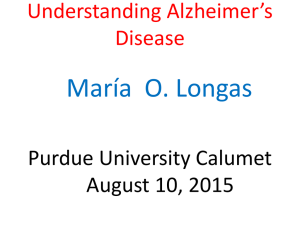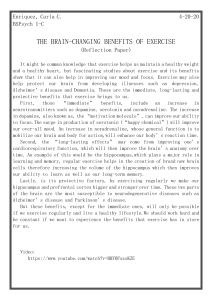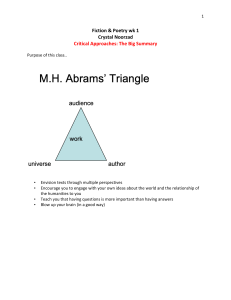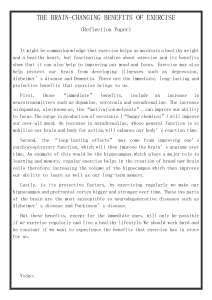Alzheimer's Disease: Amyloid, Astrocytes, and NaH Treatment
advertisement
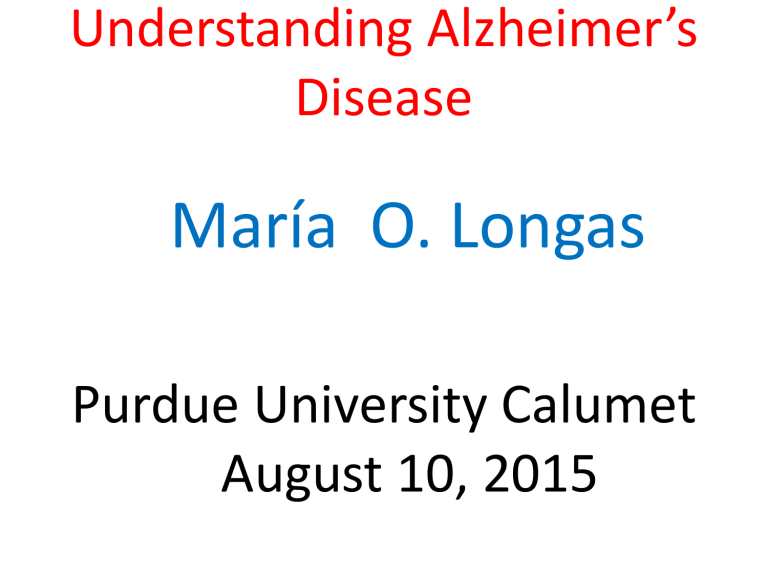
Understanding Alzheimer’s Disease María O. Longas Purdue University Calumet August 10, 2015 Alzheimer’s disease (AD) is a degenerative disorder of the central nervous system (CNS) that is characterized by the formation of amyloid plaques. Amyloid was originally used to describe accumulation of carbohydrate-like material that reacted with iodine (3), and turned out to be amylose (4). Amylose The amyloid plaque contains D-GalNAc and amyloid (a polysaccharide of glucose), they slow glucose transport in the brain . Astrocytes Release Cytokines By Dr. Ananya Mandal, MD. The term "cytokine" is derived from a combination of two Greek words - "cyto" meaning cell and "kinos" meaning movement. They stimulate the movement of cells towards sites of inflammation, infection and trauma. Low glutamic acid (Glu) and aspartic acid (Asp) concentrations result in deficient glucose transport (7), and stimulate astrocytes to take action against the aberration and correct it. In normal people ß-amyloid fibrils that form in the astrocyte extracellular spaces are hydrolyzed, but in Alzheimer’s disease, this binding produces astrocyte immobility (9). Astrocytes also have Glycosaminoglycan and Proteoglycans. This is a tetramer of Dermatan Sulfate Heparan Sulfate Proteoglycan Proteoglycan ASTROCYTES STOP THEIR MOBILITY UPON BINDING TO ß-AMYLOID FIBRIL Tissue Culture • Cells were cultured in Astrocyte Basal Medium (ABM) obtained from Lonza and adjusted to 15% fetal bovine serum. This media was fortified with 5.0 ml LGlutamine, 0.5 ml Ascorbic Acid, 1.25 ml Epidermal Growth Factors, 0.5 ml Insulin and 0.5 ml Gentamicin Sulfate Amphotencin-β. NaH Conditions • NaH was prepared by Sigma Life Science. The name they gave was NaH, a heparin disaccharide 1-S sodium salt. Cell Culture • Mid-frontal cerebral cortex, were the cells used in this study. • The cells were donated to us by Rush University Medical Center. Fig. 2 - Mid Frontal Cerebral Cortex of Normal Astrocytes Stained with Congo red Fig. 3 - Mid-Frontal Cerebral Cortex of Astrocytes of Alzheimer’s Patients Stained with Congo red. Fig. 4 - Mid-Frontal Cerebral Cortex of Astrocytes of Alzheimer’s Patients Stained with Congo red. • Cells were incubated at 37oC, under 5% CO2. Cultures lasted in this media for 15 days, with changes every 3rd day. After 15 days in this culture media was adjusted to NaH (Fig. 1). AD received 4 mg NaH/gram of body mass in 1 ml of sterilized phosphate buffer saline (SPBS). The controls received 1 ml SPBS/gram of body mass. Figure 1 NaH Concentration Was Increased • The concentration was then increased to 5mg NaH/gram of body mass in 1 ml of sterilized (SPBS) for the AD patients. The controls continued receiving 1 ml of SPBS/gram of body mass. • The cultures were repeated using 6 AD samples and 6 of normal controls. Figure 5 – Mid-Frontal Cerebral Cortex of Alzheimer’s Disease Tissue Stained with Congo red Figure 6 – Mid-Frontal Cerebral Cortex of Alzheimer's Disease Tissue Stained with Congo red. Figure 7-Mid-frontal Cerebral Cortex of Alzheimer’s Disease Tissue Stained with Congo red Figure 8 – Mid-Frontal Cerebral Cortex of Normal Control Tissue Stained with Congo red. Figure 9 – Mid-Frontal Cerebral Cortex of Normal Control Tissue Stained with Congo red Figure 10- Mid-Frontal Cerebral Cortex of Normal Control Tissue Stained with Congo red Rat Tissue Culture • Six Rats contracted Alzheimer's Disease at Taconic Bioscience, Inc. and 6 normal controls were obtained. They were all cultured using the normal conditions for the humans, except that a rat hippocampus was used to remove the cells for culture & no NaH. Figure 2- Rat hippocampus Normal Rat Growth Rate • Rat growth was normal as indicated by Lonza Bioscience. The growth difference can be explained by comparing the body mass of the normal controls that increased from 263.3 g, 263.4 g, 239.8 g, 231.2 g, 220.6 g and 223.2 grams from the day when they arrived in the laboratory to 438.8 g, 473.7g, 449.7g, 436.6 g, 466.6 g, and 407.9 grams when they were guillotined. Alzheimer’s Rat Growth rate • The weighs of the Alzheimer’s Disease Rats ranged from 240.2 g, 227.2 g, 257.1 g, 270.4 g, 247.3 g, and 240.0 g to 378.6 g to 415.1g, 480.4 g, 441.2 g, 437.4 g and 433.3 grams when they were guillotined. The masses were determined every other week, following the advised of a Purdue University Veterinarian. Figure 12 - Normal Rat Hippocampus Cells Stained with Congo red. Fig. 13 – Rat Alzheimer’s Disease Hippocampus Cells Stained with Congo red. NaH Was Added to Rat Culture • Cells were incubated at 37oC, under 5% CO2. Cultures lasted in this media for 15 days, with changes every 3rd day. After 15 days in this culture media was adjusted to NaH (Fig. 1). AD received 4 mg NaH/gram of body mass in 1 ml of sterilized phosphate buffer saline (SPBS). The controls received 1 ml SPBS/gram of body mass. Figure 14. Rat Alzheimer's Disease Hippocampus Cells Stained with Congo red Figure 15 – Rat Alzheimer’s Disease Hippocampus Cells Stained with Congo red. Figure 16 – Normal Rat Hippocampus Cells Stained with Congo red. Figure 17 – Normal Rat Hippocampus Cells Stained with Congo red Figure 1. NaH. • Figure 1 represents NaH. It is a heparin disaccharide or 1-S sodium salt (H9267) (C12H15N1O19S3Na4), formula weight 665.40 g/mol. H9267 was obtained from heparin upon digestion with heparinases 1 and 2. Sigma Life Science developed the product and called Na-S sodium sulfate salt. There are no sugars in such saccharide. The special groups includes: 1 carboxyl group and 3 OH’s. Of the 3 OH’s, one is bonded to cyclohexene and the other two are boned to carbons. There is only one N, which binds a sulfate and it is near the ketone group. CONCLUSIONS • Alzheimer’s Disease Patients should be treated with a disaccharide that originates from anticoagulant heparin, like the one shown in this Figure. Fig. 18 – Alzheimer’s Disease Rat Hippocampus Cells. • The so called NaH (a heparin disaccharide) used in this study, has a very distorted structure to work like anticoagulant heparin. GAG Sulfotransferase/Sulfatase Dance Sulfates we give to the GAG’s To help them do their jobs. When we get tired or crippled The GAG’s defects become tripled They surely need our help To do their functions well With the GAG’s in disarray The cells begin to decay And the turmoil is such That we cannot even DANCE. Congo Red Staining Tissue culture hippocampus and media sere separated; the cultures were then washed with excess sterile NaCl; 100 μL of NaCl containing hippocampus tissue was placed in an electrophoresis plate to prepare for Congo red Staining (6). NaCl (35.71 g) was dissolved in 100 ml of 80% w/w Ethanol; Congo red (0.8192 g) was added, and the solution was boiled with mixing for 5 min. This solution was allowed to stand at room temperature for 24 hr. Just before use, 9 parts of Congo red solution were combined with 1 part of 1% (W/V) NaOH; the solution was filtered, and
